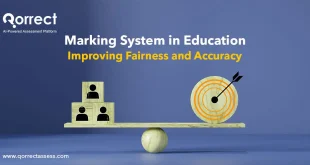The difference between different types of evaluation, especially the difference between formative evaluation and summative evaluation, is a very vital topic every educator should know about; in order to perfectly employ each type within the teaching process and to conduct good tests.
Formative and summative evaluation are among the most common and important types of evaluation as they complement each other and influence the quality of the whole educational process.
The difference between formative and summative evaluation is nothing more than an attempt to understand each type of them, then use them in the desired way and combine their results to maximize the evaluation benefits.
In this blog, we briefly review the different types of assessments and explain some of the differences between formative and summative evaluation, and also discuss the role of digital systems in improving evaluation results.
Table of Contents
What is the difference between Formative and Summative Evaluation?
Evaluation in education refers to measuring the degree to which learners understand the curriculum, with the goal of accurately determining which educational purposes have or have not been met.
There are many types of educational assessment, the most common of which are:
- Pre-assessment.
- Formative assessment.
- Diagnostic assessment.
- Summative assessment.
Visit our blog and learn more about the latest Methods for Assessing Students.

Formative and summative evaluation are the most common types of evaluation, and it is important to clarify the difference between formative and summative evaluation.
Robert Stick, a professor at the University of Illinois, describes the difference between formative and summative evaluation by saying:
“When the chef tastes the soup, that’s formative evaluation, but when the guests taste the soup, that’s summative“.
To understand this saying, the following table shows the difference between formative and summative evaluation.
The difference between formative and summative evaluation
| Formative evaluation | Summative evaluation |
| An assessment process that is applied throughout the existing learning process. | An assessment method used after the learning process is completed, such as exams at the end of a unit, semester, or academic year. |
| It measures the extent to which educational goals are achieved in the short term, such as a learner’s mastery of a concept or understanding of an experiment. | It measures the degree of long-term achievement of educational objectives, such as learner achievement percentage or overall understanding of the course. |
| It provides feedback on the degree of understanding and effectiveness of the educational methods during the ongoing learning process and then contributes to their development. | Provides feedback on the degree of understanding and effectiveness of instructional courses and practices in achieving ultimate educational goals in order to develop the learning process in the next phases. |
| A quick and short procedure, its application does not require much time and effort. | It is a lengthy process that takes time to prepare and implement. |
| It aims to improve the learning process and raise the performance level of learners based on the (feedback) given by the educator. | It aims to assess the learner’s competence to understand school courses based on the criteria (grades) achieved by the learner. |
| It is done by educators, learners, peers, and parents. | Educators are solely responsible for the summative evaluation. |
| Informal process. | Formal process. |
While talking about the difference between formative and summative evaluation, it should be noted that the main difference between formative and summative evaluation that clearly separates them is how the results of the evaluation process are used.
If the results are used to assess the effectiveness of the curriculum in achieving educational goals after the completion of the education process, the evaluation is summative.
But if the results are used to create an updated picture of the curriculum, learners, and educators’ performance, the evaluation is formative.
To better understand the difference between formative and summative evaluation and its use in the learning process, let’s take a closer look at the concept, models, and strategies of each type.
Summative evaluation
Summative evaluation definition refers to the type of evaluation carried out at the end of a curriculum or course, such as final exams, mid-term exams, final projects, etc.
It aims to assess learners’ performance based on their grades and to compare learners’ results to determine the extent to which the objectives of the educational process are being met.

In order to achieve accurate results and effective impact, the summative evaluation is based on the following factors:
Curriculum compatibility
In summative evaluation, learners are not assessed on the knowledge they have not learned, but on what they have learned.
In this way, evaluation is appropriate to determine whether the educational objectives have been met.
Variety of questions
The summative evaluation contains different types of questions to measure the learners’ level of knowledge in different ways.
Regular evaluation
Learners’ results are reviewed at regular intervals according to their progress at different stages of learning.
Reports
Summative evaluation provides various reports on the level of assessment, student performance, etc.
These reports are used to prepare curricula and adopt educational policies at subsequent educational levels.
If you are looking for a variety of accurate reports on student evaluation, you have no alternative to Qorrect system.
Summative evaluation examples
There are different examples of summative evaluation, listed below:
- Written final exams: the most common form worldwide.
- Semi-annual exams: such as monthly exams, mid-term exams, or end-of-semester exams.
- Practical tests: such as physical or chemical experiment tests in scientific colleges.
- Final oral exams: Students submit an oral examination individually or collectively at the end of the course or educational program to a teacher/professor or group of teachers/professors.
- Research projects: includes collaborative or individual projects and papers.
- Presentations: prepared individually and jointly.
- Student Portfolios: like paintings done by art students during the school year.
- Admission tests such as SAT, IELTS, and TOEFL.
When preparing a summative evaluation, it is necessary to use a variety of questions to evaluate students and ensure that the assessment is relevant to the topic being studied and combines academic knowledge with applied practice.
Summative evaluation in education
Summative assessment in education has the following meaning:
- Monitoring the grades of learners at different levels of education to identify successful and unsuccessful learners.
- Identifying the class of learners enrolled in a particular college, department or course, etc.
- Measuring the effectiveness of the learning process and the efficiency of teaching methods.
- Determining the effectiveness and relevance of curricula and policies for learners and their different levels.
- Providing an objective criterion to be relied upon in the development of the educational process and in decision-making regarding the change and improvement of the educational system in its various pillars.
It’s also an organized process, as it takes into account the following:
- Exams period.
- Those responsible for preparing and correcting the tests.
- Correction method.
- Preparation of answer forms.
- Confidentiality of the questions.
To achieve the desired impact on the quality of the educational process, summative evaluation relies on a variety of strategies and methods.
Summative evaluation strategies
Summative evaluation strategies are divided into two main types:
Traditional strategy
This strategy is based on traditionally familiar forms of summative evaluation such as written tests.
This strategy focuses on assessing the learner’s academic performance, and relevant skills such as writing skills, language skills, and so on.
Creative Strategy
This strategy uses various forms of summative evaluation such as final projects, research papers, and student portfolios.
This strategy focuses on measuring students’ ability to apply academic knowledge to their real lives, as well as other relevant skills such as teamwork, time management, and leadership.
It should be noted that it is important to integrate both strategies into any summative evaluation process; to make a more accurate assessment and to develop the educational process more effectively.
Summative evaluation methods
The summative evaluation methods are divided into the two following methods:
Pen Paper Tests
It is a classic accepted form in various educational institutions that requires a lot of time and effort to prepare, monitor, and correct.
E-assessment
Electronic testing is a new direction that started to be used as a new way of summative evaluation that helps to reduce the time, effort, and cost of conducting tests.
Formative Evaluation
Formative evaluation refers to this type of evaluation that occurred during the instructional process; in order to deliver results and data that can measure the level of learners and the effectiveness of educational practices.
Learners can use these findings to identify their strengths and weaknesses and change their learning styles in a way that develops their weaknesses and improves their strengths.
Educators also can also use the results to determine learners’ academic progress.
This evaluation is done at an early stage so that both educators and learners have the opportunity to develop their own teaching and learning processes and address their deficiencies before they reach the end of the educational program and take a summative evaluation.

Formative assessment helps both educators and learners determine if the learner has mastered a skill or a knowledge or if they need more time to master it and how to use that time effectively!
In this way, formative evaluation contributes to the following:
- Defines concepts and skills that are difficult for learners to understand or master.
- Reconstruct education programs and correct teaching methods to adapt them to the level of
- learners and support their learning process.
- Steer the educational treatment plan in the right direction.
- Establish the concept of independence for learning in the hearts of learners.
Formative evaluation is characterized by the fact that it encompasses all learning objectives, is repeated at different stages of the educational process, and is analytical because it is based on the analysis of the learners’ results.
Formative Evaluation Examples
The formative evaluation aims to discover the problems that learners face during the educational process and resolve them before they escalate.
To this end, educators employ a number of strategies to conduct a formative evaluation.
Among the best-known of these strategies are the following:
Summary
In this process, the educator asks students to provide a written or oral summary of what has been explained.
Debate
After the explanation, the educator asks the students to share questions about the topic of the explanation.
Through the discussion that takes place among the learners, the educator can see what the learners understand and what difficulties they are facing.
Competition
At the end of the explanation, the learner conducts a competition of short questions about what was explained and determines the level of understanding of the topic based on students’ answers.
Open-ended questions
Closed-ended questions are generally not a good way to assess a student’s understanding of a lesson.
On the other hand, open-ended questions allow the educator to know what the students have learned, what things are on their minds and other things that are difficult to learn or even remember.

Thinking
At the end of the explanation, the educator gives students a few minutes to think about how they can apply what they have learned to their lives.
Afterward, a discussion is conducted among the students about the main ideas written down.
Errors
In this strategy, the educator provides incorrect information that contradicts what he or she has explained and observes the learners’ reactions.
Do they notice the mistake or not?
And if they notice it, how do they refute it? In this way, the educator knows the extent to which the learners understood what he explained.
(1/2/3)
This strategy is based on three questions that are asked to the learners after the explanation.
Based on their answers, the educator determines the learners’ level of understanding and the effectiveness of the teaching method.
These three questions relate to what learners learned from the explanation, what points they emphasized most that they would like to explore further, and whether they have any questions they would like to ask.
Exit ticket
At the end of the explanation, the teacher asks a question and asks learners to write the answer on a piece of paper.
Each learner delivers his/her answer sheet as a ticket to leave the class.
The most important point / the most difficult point
In this strategy, the educator asks the learners for the most important information they learned in the lesson and the most difficult information to understand.
It should be noted that formative assessment has less to do with when the assessment is administered or what parts of the course it covers, and more to do with its purpose and how its results are used to achieve that purpose.
For formative assessment to achieve the desired goal, it depends on more than one form, such as follows:
- Classroom discussions.
- Monitoring learner performance.
- Homework assignments.
- Instructions from the educator.
And there are many examples of formative evaluation that we could mention, for example:
- A literature professor explains criticism of a literary trend, then discusses it with students and listens to their opinions.
- A physics professor instructs his students to look for the latest findings of scientists on the theory of parallel universes to discuss in the next lecture.
- A politics professor explains the different systems of government and then asks the students to apply what they have learned to solve the governmental crisis in Lebanon.
As we can see, the different examples of formative evaluation aim to measure and improve the student’s learning skills and support educators’ pedagogical practices, in the context of the different efforts to develop the education system and activate its role in society.
How does Qorrect system help you maximize the benefits of formative and summative evaluation?
After clarifying the difference between formative and summative evaluation, and recognizing their importance in the development of the educational process, some educators in educational institutions may be concerned about the time and mechanisms they need to activate and use these two types of evaluation.
Qorrect system is here to help you create a more accurate and effective assessment by providing you with the following features:
- Preparing all forms of tests that will help you achieve your desired educational goals.
- A thorough analysis of learners’ results and quick and comprehensive reports on all aspects of the assessment process.
- Maintaining test confidentiality and administering tests within a tight security framework and effectively combating cheating.
- Reducing the time and effort required to create and correct tests by automating the correction.
- In addition, you can create question banks with countless questions in simple and easy steps.
From formulating questions and administering traditional or electronic tests to analyzing results and generating reports, Qorrect system helps you step-by-step and increases the quality of every type of assessment you administer.
Book a free demo now and contact one of our experts to find out more!
References:
https://en.wikipedia.org/wiki/Formative_assessment
https://vcsa.ucsd.edu/_files/assessment/resources/50_cats.pdf
https://www.igi-global.com/dictionary/summative-evaluation/28712
 Qorrect Blog
Qorrect Blog






